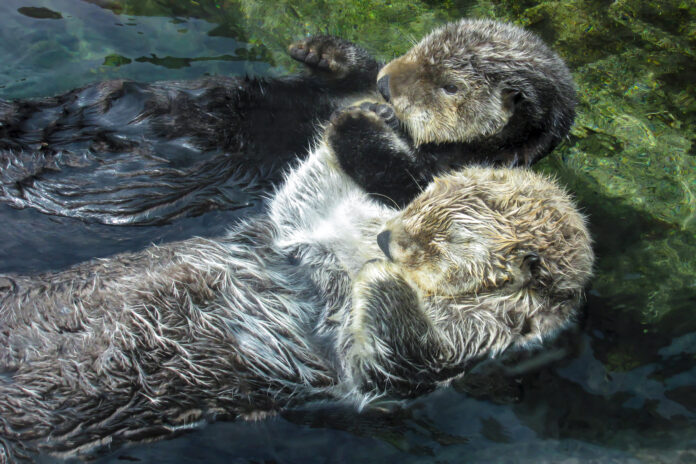You may have seen it on social media, or even at an aquarium — sea otters cuddling and even holding hands (or rather, paws) while sleeping.
Sea otters have long been beloved for their fuzzy coats and rambunctious personalities, but when a video of two sea otters holding paws while sleeping at the Vancouver Aquarium went viral in 2007, people around the world began to associate this heart-warming image with otters.
Sea Otters Holding Hands
[embedded content]
It’s quite rare to see sea otters holding paws, especially in the wild. Otters are known to be very social creatures with strong individual personalities, and researchers have speculated that such displays of affection might just be personal quirks, unique to individual sea otters.
However, otters are known to cuddle while sleeping, or at least to sleep close to each other, to prevent themselves from drifting apart in the open ocean. These distinctive social patterns — and the ways in which they impact kelp forests in sea otters’ natural range — are a key part of what makes them so important to ecosystems in the northern Pacific.
Sea Otters Sleep in Large Groups Called ‘Rafts’
A sea otter raft off the coast of California. (Credit: Neil Aronson/Shutterstock)
In the wild, sea otters typically travel and sleep in large groups known as ‘rafts’. Rafts are typically segregated by gender, and otters stay connected to others in the raft through more casual physical contact, or by wrapping themselves in kelp. Forming rafts helps sea otters stay protected from predators, conserve energy, and keep warm while they nap.
These functions are particularly important for wild sea otters because, unlike many other aquatic mammals, they don’t have a layer of blubber to keep them warm. Their thick fur coats are their main source of warmth, but they also rely on burning calories for heat, meaning they eat up to 25 percent of their body weight on any given day.
In short, resting in large groups helps sea otters stay warm, while also preventing them from having to expend energy to defend themselves against predators.
Read More: These Animals Get Creative To Get Some Sleep
Groups of Sea Otters Can Get Pretty Big
Rafts can vary widely in size, from less than 10 individuals to more than 100, with a typical size of around 50 otters. In early 2023, “super-rafts” of over 200 otters were spotted off the coast of Monterey, California — but even the two otters from the viral video at the Vancouver Aquarium could be considered a raft.
Whether they’re just two otters or hundreds, raft sightings are a promising sign that sea otter populations are on the rise again. Sea otters were hunted nearly to extinction in the 1800s to fuel the growing fur trade, but, in recent years, they’ve been reintroduced to their natural habitat in central and southern California.
Read More: Yes, Animals Create Culture and Pass It Along for Survival
How Many Sea Otters Are Left?
According to the U.S. Fish and Wildlife Service, there are about 3,000 southern sea otters living off the coast of California today — a decline from their historical peak population of around 17,000, but certainly an improvement over previous years.
Meanwhile, in the northern Pacific, sea otters are considered a keystone species — a species that upholds the natural structure of a given ecosystem. And their reintroduction to their natural habitat is having major positive impacts on other plants and animals in this ecosystem.
More recently, researchers at the Monterey Bay Aquarium found that sea otters had positive impacts on kelp populations on the central California coast. That study, published in the journal PLOS Climate in 2024, analyzed kelp population data from 1910 to 2016, and found that there was major growth in the kelp canopy in areas with high sea otter populations.
“In fact, we found sea otter population density as the strongest predictor of change in kelp canopy coverage across this hundred-year span,” said study author Teri Nicholson, a biologist with the Monterey Bay Aquarium Sea Otter Program, in a press release.
So whether they’re cuddling, holding paws or just floating along together, one thing’s for certain — scientists and animal lovers alike are happy that sea otters are back.
Read More: Could Sea Otters Help Save California’s Vanishing Kelp Forests?
Article Sources
Our writers at Discovermagazine.com use peer-reviewed studies and high-quality sources for our articles, and our editors review for scientific accuracy and editorial standards. Review the sources used below for this article:
Source : Discovermagazine















